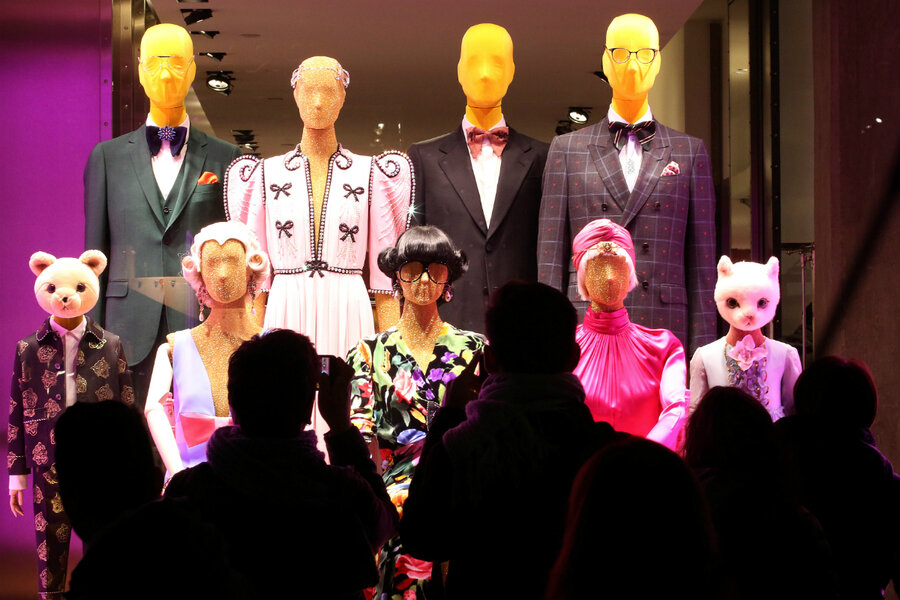Faux fur makes inroads in high fashion
Loading...
Luxurious mink coats, fox-trimmed capes, alligator purses, beaver hats. Animal fur has long played a central role in high-end fashion houses. But the 2018 luxury collections are poised to reflect a growing consumer preference toward faux fur.
Gucci’s chief executive officer, Marco Bizzarri, announced in October that starting with the spring 2018 collection, none of the fashion house’s designs will feature real animal fur. While many fashion brands that fall in the high-end, ready-to-wear category – such as Armani, Hugo Boss, and Ralph Lauren – began dropping real fur as early as 2007, Gucci is the first luxury brand to commit to the prevention of animal cruelty in fashion.
“Creativity can jump in many different directions instead of using furs,” said Mr. Bizzarri at the London College of Fashion.
Adding Gucci’s voice to the anti-fur movement has animal welfare activists saying that this is a turning point, especially among luxury brands, to reduce the millions of animals raised each year only for their fur. Statistics released by People for the Ethical Treatment of Animals (PETA) show that 1 billion rabbits and nearly 5 million other animals such as mink and coyote are killed each year for their fur.
“Gucci going fur-free is a huge game-changer that will not go unnoticed in the world of fashion,” says Kitty Block, president of Humane Society International in an email to the Monitor. “Gucci’s compassionate decision will no doubt lead others to shun fur.”
The growing number of consumers who want sustainable and socially responsible products is the driving force behind this change.
Even supermodels are joining the effort. On the August cover of Paris Vogue, Gisele Bündchen is draped in golden brown faux fur, with a cute baby kangaroo tucked under her arm.
“So happy that @vogueparis dedicated this issue to animal protection, sending a strong message that wearing real fur is never an option!! All great designers now do beautiful #fakefur,” Ms. Bündchen wrote in an Instagram post about the cover shoot.
Organizations such as PETA have played a large role in this shift of thought, says Mukta Ramchandani, a PhD candidate who has published research on ethical practices in fashion. She notes a direct link between consumer awareness and campaigns by these organizations.
For many brands, going fur-free is largely a business and marketing decision. But some noted designers are already committed to vegan fashion. Stella McCartney’s 2017 collections used no animal products, and many of her designs incorporated slogans, such as a T-shirt dress with the message “NO FUR” and a jumpsuit that read “NO LEATHER.”
Innovations in synthetic materials have helped to make numerous leather substitutes and faux fur more realistic in both feel and look. But synthetic materials don’t solve all the issues, according to Henry Navarro, associate professor of fashion at Ryerson University in Toronto. The production process can be wasteful and harmful to the environment, and for many luxury designers the quality of synthetic materials does not compare to that of the real thing. Until synthetic manufacturing improves considerably, another option is ethically sourced fur, Professor Navarro says. “[I]t doesn’t alienate people who are both concerned about the environment but they want to have a nice experience with their garments.”
Companies such as Canada Goose, which uses coyote fur to trim its cold-weather jackets because synthetic fur does not protect as well against extreme temperatures, say they are striving to promote socially responsible practices.
“[W]e never purchase fur from fur farms, never use fur from endangered animals, and only purchase fur from licensed North American trappers strictly regulated by state, provincial and federal standards,” reads a 2017 statement by Canada Goose.
As for Gucci, the company’s recent decision suggests that luxury fashion and sustainability can coexist. As Navarro points out, luxury is defined by its craftsmanship and cutting-edge, sophisticated design – not necessarily by the materials used. As new synthetic materials are developed, luxury brands will begin to incorporate them into new designs as consumers continue to demand cruelty-free products.
And for those concerned that customer desire for social responsibility in fashion is a fad, Navarro believes this trend is here to stay. “It’s a factor of doing good fashion, doing business, being in the 21st century.”








